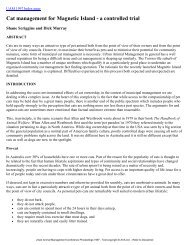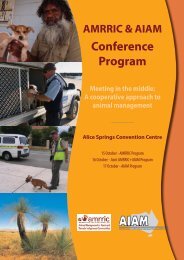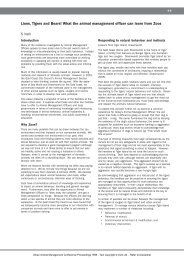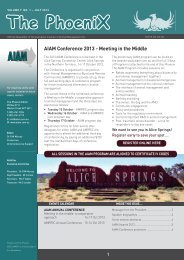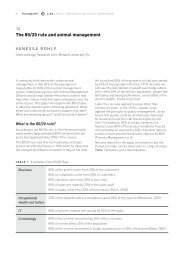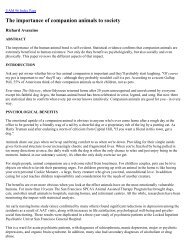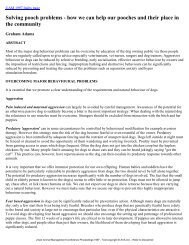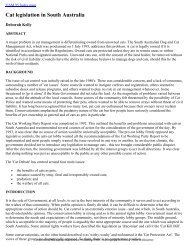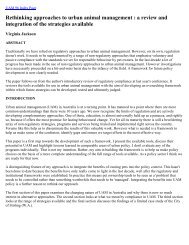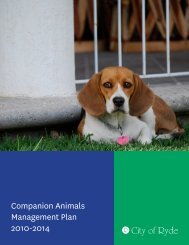Proceedings OF ThE - Australian Institute of Animal Management Inc
Proceedings OF ThE - Australian Institute of Animal Management Inc
Proceedings OF ThE - Australian Institute of Animal Management Inc
Create successful ePaper yourself
Turn your PDF publications into a flip-book with our unique Google optimized e-Paper software.
92 <strong>Proceedings</strong> 2012<br />
AIAM Annual Conference on <strong>Animal</strong> <strong>Management</strong><br />
Rationalisation for change<br />
The New South Wales judicial system when used for<br />
dealing with human <strong>of</strong>fenders is also tiered, where<br />
by first time <strong>of</strong>fenders are given a lenient penalty or<br />
a minimal custodial sentence. This penalty is given<br />
where the circumstances involving the incidents<br />
are minor; however, should this person re-<strong>of</strong>fend<br />
the penalties are increased and adjusted to suit the<br />
crime.<br />
When dealing with companion animals, this similar<br />
approach could be applied, as in most cases there<br />
are mitigating circumstance that must be taken into<br />
consideration when applying a control order.<br />
Often, when a dog has committed an <strong>of</strong>fence, i.e.<br />
roaming, nuisance or a dog attack, these <strong>of</strong>fences<br />
can be traced back to their owner’s responsibility or<br />
person/s in charge <strong>of</strong> the dog at the time.<br />
• yMaybe a gate is left open by a visitor to the<br />
property and the dog roams or the owner is not<br />
responsible to care for their dog appropriately; or<br />
• yThe owner is not aware or responsible to ensure<br />
their dog’s actions or noise emanating from the<br />
dog are controlled; or<br />
• yThe owner has not socialised their dog with<br />
humans or other dogs and it has been allowed<br />
to display various levels <strong>of</strong> aggression without<br />
correction<br />
The dog may be the catalyst for applying control<br />
orders; however, should the dog be guilty <strong>of</strong> an<br />
<strong>of</strong>fence when acting on instinct?<br />
If the control orders were broken down as previously<br />
mentioned in this document, then the dog’s welfare<br />
could be taken into account and have the appropriate<br />
levels <strong>of</strong> control orders to fit the crime.<br />
The owner’s ignorance or inability to take<br />
responsibility for their dog’s behaviour should not<br />
be held against the dog who is acting on instinct,<br />
the natural drive that is present in most breeds to a<br />
varying degree.<br />
It must be remembered dogs can think, however, they<br />
cannot reason.<br />
Typical scenarios<br />
Case 1<br />
Bailey, Female American Bulldog, lifetime registered<br />
and desexed<br />
Chronology<br />
2 November 2010 dog attack at Illawong Ave.<br />
Subject dog attacked a cat caused<br />
life ending injuries to the cat.<br />
10 November 2010 Warning letter sent to owner<br />
advising <strong>of</strong> the attack and that any<br />
further attack may result in dog<br />
being declared dangerous.<br />
B<br />
B<br />
O<br />
I<br />
bailey escaped from her property<br />
and attacked and killed a cat,<br />
Bailey was roaming for a short<br />
time when she noticed a cat, the<br />
cat ran, and Bailey gave chase<br />
and killed the cat.<br />
bailey was impounded by Council<br />
for roaming on the street.<br />
owner interviewed who stated:<br />
“Bailey has never liked cats”. A<br />
hole in the fence on the owner’s<br />
property was identified as the<br />
location Bailey escaped through.<br />
infringements and warning letter<br />
were issued for attack.<br />
18 May 2011 dog attack on Caloola Ave.<br />
Subject dog attacked a cat caused<br />
life ending injuries to the cat.<br />
Bailey and an accomplice “Abbey”<br />
(GSD X) sniffed out, attacked and<br />
killed the cat.<br />
O<br />
owner once again stated: “Bailey<br />
doesn’t like cats” and thought it<br />
“OK” for cats to be killed by dogs,<br />
especially if the cat was feral or<br />
unregistered. Bailey had escaped<br />
through the same hole in the<br />
fence as the previous attack.<br />
1 June 2011 Notice <strong>of</strong> Intention to Declare Dog<br />
Dangerous was served.<br />
7 June 2011 owner <strong>of</strong> dog makes<br />
representations in response to the<br />
Notice <strong>of</strong> Intention.<br />
9 June 2011 Council responds to the Owner’s<br />
representations by way <strong>of</strong> letter.<br />
17 June 2011 dog declared dangerous on 17<br />
June 2011



